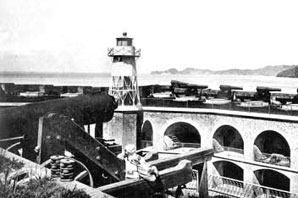"That may have been the first shot of the Civil War in California, was this duel that signaled the break-up of the Democratic Party over the slavery issue," Guarneri said, "and by extension, over whether they were going to support the Union or the Confederacy."
The San Francisco Bay Area had a few big benefits for the Union Army: gold and men. Guarneri says that roughly $185 million in federally-held gold was shipped through the Golden Gate back east to support the Union. Civilian money also went to the United States Sanitary Commission, a charity that provided humanitarian aid to Union soldiers.
As for the men, many of them didn't go east to fight in the Civil War, but rather took the place of federal soldiers stationed in California to man tribal outposts. Californians stayed behind to keep an eye on native tribes that were being colonized.
Guarneri says the state supplied about 16,000 men out of a population of 400,000 people. Three-fourths of them stayed behind at tribal forts. California's distance from the war fronts exempted it from the draft, but 400 soldiers volunteered with a Massachusetts regiment in exchange for a free ride back east. They fought in more than 50 battles, and more than 250 died.
Confederates suffered from a lack of funds; the Union was much better stocked. Some Confederate supporters hoped California would remain more or less neutral, like Kentucky. Still, they had ambitions on capturing what are now Arizona and New Mexico hoping to build a corridor to Southern California.
"(The Confederacy) had a lot of sympathizers there," said Guarneri. "They had planned to build a transcontinental railroad through that territory... and they figured that this might be a way for them to move all the way to the West Coast, so the Confederacy would stretch, like the Union, from coast to coast."
Civil War history remains visible in the Bay Area, if you know where to look. San Francisco's Union Square named just before war broke out in support of the Union cause. The Army built Fort Point immediately prior to the war, though it never saw battle. Guarneri says Angel Island in San Francisco Bay has the remnants of a Civil War-era training camp. Occasionally it also hosts re-enactments.
And some big names passed through California, too. Future Northern heroes Ulysses S. Grant and William Tecumseh Sherman both saw Army service here. On the Southern side, Albert Sidney Johnston, killed while leading Confederate troops against Grant and Sherman at the 1862 battle of Shiloh, was the federal commander on the West Coast and based in San Francisco. General Irwin McDowell, who led Union forces at the first battle of Bull Run, is buried at the Presidio, Guarneri says, as is Oregon Senator Edward Baker, who died in the 1861 battle of Ball's Bluff. Union Cemetery in Redwood City also has a section of graves of Civil War soldiers.
But of course, the living history of the Civil War carries on with re-enactment groups. Several operate in California. You'll find two of them here and here.
